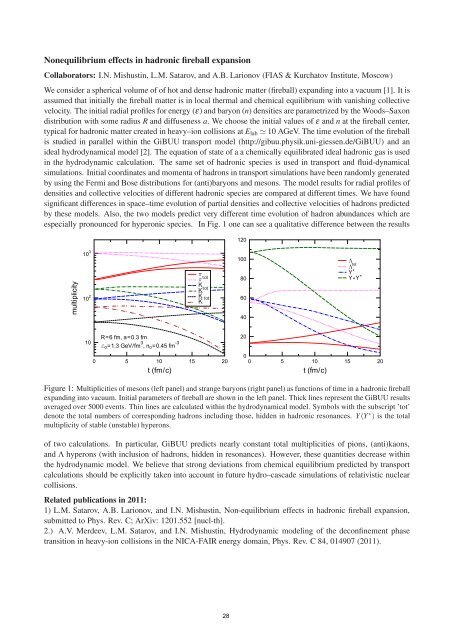FIAS Scientific Report 2011 - Frankfurt Institute for Advanced Studies ...
FIAS Scientific Report 2011 - Frankfurt Institute for Advanced Studies ...
FIAS Scientific Report 2011 - Frankfurt Institute for Advanced Studies ...
You also want an ePaper? Increase the reach of your titles
YUMPU automatically turns print PDFs into web optimized ePapers that Google loves.
Nonequilibrium effects in hadronic fireball expansion<br />
Collaborators: I.N. Mishustin, L.M. Satarov, and A.B. Larionov (<strong>FIAS</strong> & Kurchatov <strong>Institute</strong>, Moscow)<br />
We consider a spherical volume of of hot and dense hadronic matter (fireball) expanding into a vacuum [1]. It is<br />
assumed that initially the fireball matter is in local thermal and chemical equilibrium with vanishing collective<br />
velocity. The initial radial profiles <strong>for</strong> energy (ε) and baryon (n) densities are parametrized by the Woods–Saxon<br />
distribution with some radius R and diffuseness a. We choose the initial values of ε and n at the fireball center,<br />
typical <strong>for</strong> hadronic matter created in heavy–ion collisions at Elab � 10 AGeV. The time evolution of the fireball<br />
is studied in parallel within the GiBUU transport model (http://gibuu.physik.uni-giessen.de/GiBUU) and an<br />
ideal hydrodynamical model [2]. The equation of state of a a chemically equilibrated ideal hadronic gas is used<br />
in the hydrodynamic calculation. The same set of hadronic species is used in transport and fluid-dynamical<br />
simulations. Initial coordinates and momenta of hadrons in transport simulations have been randomly generated<br />
by using the Fermi and Bose distributions <strong>for</strong> (anti)baryons and mesons. The model results <strong>for</strong> radial profiles of<br />
densities and collective velocities of different hadronic species are compared at different times. We have found<br />
significant differences in space–time evolution of partial densities and collective velocities of hadrons predicted<br />
by these models. Also, the two models predict very different time evolution of hadron abundances which are<br />
especially pronounced <strong>for</strong> hyperonic species. In Fig. 1 one can see a qualitative difference between the results<br />
multiplicity<br />
10 3<br />
10 2<br />
10<br />
R=6 fm, a=0.3 fm<br />
0=1.3 GeV/fm 3 , n 0=0.45 fm -3<br />
tot<br />
K<br />
K tot<br />
K<br />
K tot<br />
0 5 10 15 20<br />
t (fm/c)<br />
120<br />
100<br />
80<br />
60<br />
40<br />
20<br />
0<br />
0 5 10 15 20<br />
t (fm/c)<br />
Figure 1: Multiplicities of mesons (left panel) and strange baryons (right panel) as functions of time in a hadronic fireball<br />
expanding into vacuum. Initial parameters of fireball are shown in the left panel. Thick lines represent the GiBUU results<br />
averaged over 5000 events. Thin lines are calculated within the hydrodynamical model. Symbols with the subscript ’tot’<br />
denote the total numbers of corresponding hadrons including those, hidden in hadronic resonances. Y(Y ∗ ) is the total<br />
multiplicity of stable (unstable) hyperons.<br />
of two calculations. In particular, GiBUU predicts nearly constant total multiplicities of pions, (anti)kaons,<br />
and Λ hyperons (with inclusion of hadrons, hidden in resonances). However, these quantities decrease within<br />
the hydrodynamic model. We believe that strong deviations from chemical equilibrium predicted by transport<br />
calculations should be explicitly taken into account in future hydro–cascade simulations of relativistic nuclear<br />
collisions.<br />
Related publications in <strong>2011</strong>:<br />
1) L.M. Satarov, A.B. Larionov, and I.N. Mishustin, Non-equilibrium effects in hadronic fireball expansion,<br />
submitted to Phys. Rev. C; ArXiv: 1201.552 [nucl-th].<br />
2.) A.V. Merdeev, L.M. Satarov, and I.N. Mishustin, Hydrodynamic modeling of the deconfinement phase<br />
transition in heavy-ion collisions in the NICA-FAIR energy domain, Phys. Rev. C 84, 014907 (<strong>2011</strong>).<br />
28<br />
tot<br />
Y*<br />
Y+Y*
















